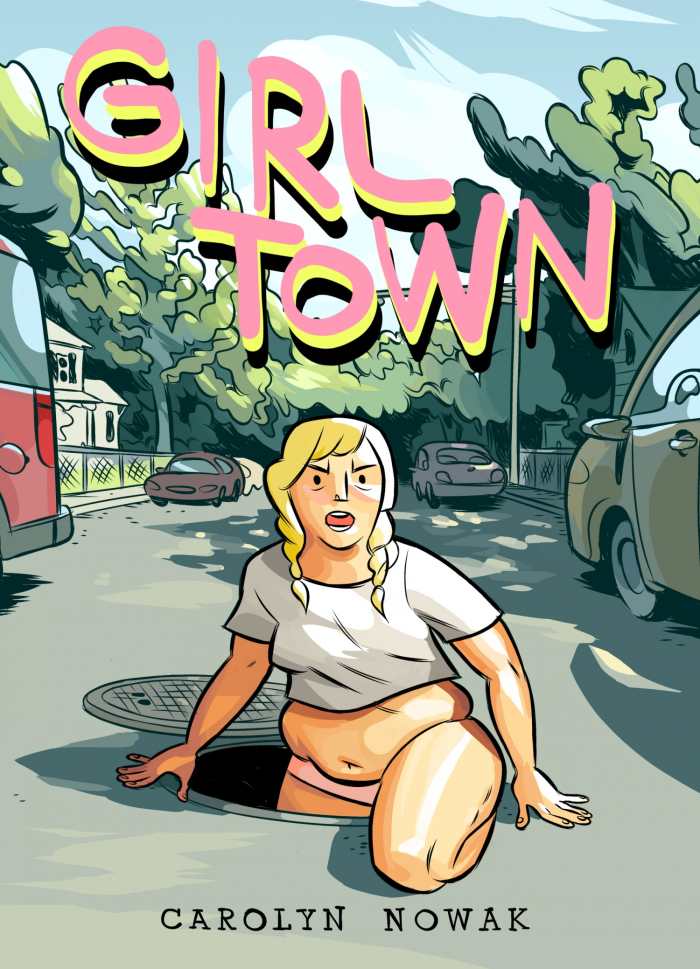Book of the Day Roundup October 1–5

Girl Town

Carolyn Nowak
Top Shelf Productions
Softcover $19.99 (160pp)
978-1-60309-438-2
Buy: Local Bookstore (Bookshop), Amazon
Carolyn Nowak’s Girl Town is an intriguing, masterful celebration of girls and girlhood that honors young women of every shape, color, and identity with spellbinding, vivid art.
Five self-contained comics utilize Nowak’s charming, vibrant illustrations to expertly develop a one-of-a-kind plot. Comic-book medium aside, Girl Town is for girls who are at least in high school, as it explores adult themes and images.
In “Girl Town,” the humorous politics of a neighborhood feud come to light. The heartwarming “Radishes” tells the story of two girls who play hooky and discover the nearby fantasy market, while “Diana’s Electric Tongue” chronicles a love story between girl and robot. These are the collection’s standout entries; each crafts a familiar but quirky universe with expert world-building. Tiger cafés in lieu of cat cafés; radishes with mystical powers—subtle but powerful creativity abounds.
Nowak plunges into the world of feminine friendships in earnest. The girls in this book are flawed, unique, and complex, just like real girls around the globe: They crack jokes, they make mistakes, they fall in love. As they grow, each story puts forth universal and necessary takeaways—ideas about accepting yourself and others, moving past trauma, or just remembering to have fun. In addition to their meaningful messages, the stories are laugh-out-loud funny. Pithy one-liners and deadpan humor fill the pages, complementing the collection’s deeper side.
The art is truly gorgeous. Nowak illustrates with clean, crisp lines to create fresh, charming settings. Everything feels fluid; dynamic characters come to life. The skillful juxtaposition of panels and text allows for easy comprehension, and the color palette varies from story to story, always matching the atmosphere and tone.
Girl Town is a cerebral, spirited work of art.
MYA ALEXICE (October 1, 2018)
Love Songs for a Lost Continent

Anita Felicelli
Stillhouse Press
Softcover $16.00 (264pp)
978-1-945233-04-3
Buy: Local Bookstore (Bookshop), Amazon
“How easily the fictions that a closed circle of people told each other could grow wings, take flight as if they were the truth,” declares “Deception,” the opening story in Anita Felicelli’s Love Songs for a Lost Continent. This logic penetrates the collection; paradigms topple and shift like dominoes as protagonists careen from displacement toward personal truth, each hoping they might find their way. The results are transcendentally messy, the characters’ trouble electric.
Most characters share ethnic or cultural ties to the Indian subcontinent; Tamil people “longing for origins … that might never have existed.” Their experiences are diasporic, spanning India, the United States, France, and Madagascar, from where they unpack their identities for themselves rather than performing them for a colonial gaze, even when they wrestle with issues of culture, race, and ethnicity.
Recurring ties between parents, children, and places invoke questions about heritage and inheritance—cultural, mental, and physical. Felicelli plays with the personal and cultural tensions that exist between being a part of and apart from.
Every protagonist is given permission to exist in a way that’s not only engaging but also thrilling. A teenager on a family trip back to India claims his sexuality on an illicit trip to the bazaar with an elephant polo player. Young women contend with parents’ higher-education dreams, yet each is delivered to her own unique destination, none wholly flourishing or failing. The privilege and price of an upper-middle-class existence are confronted, from a young woman whose ennui finds an outlet in the long con to another who impetuously moves to a Madagascar vanilla farm with her boyfriend.
Love Songs for a Lost Continent revels in the murky in-between spaces where the monstrous intersects with the benign and something essential is revealed. Across the collection, love and pain, displacement and connection, personal identity and culture are reconfigured until even the most prosaic home becomes lethally wistful.
LETITIA MONTGOMERY-RODGERS (October 1, 2018)
Freedom and Despair
Notes from the South Hebron Hills

David Shulman
University of Chicago Press
Softcover $18.00 (224pp)
978-0-226-56665-8
Buy: Local Bookstore (Bookshop), Amazon
“Some risks are worth taking, but it’s better not to ask why,” writes David Shulman. “Then there are the risks that you have to take if you want to feel human.” This reflection comes after another long day of resistance in South Hebron, where he gathers with Palestinians and fellow Israelis to protest the relentless settler takeover of Palestinian land.
It is an often discouraging process. On more days than not, settlers and police forces beat the resistance back, sometimes making arrests, sometimes landing bone-breaking blows. But Shulman, whose family background includes pogroms and persecutions and whose sensibilities are rooted in a decidedly fair-minded Judaism, knows that he has to persist. The tide will turn, he believes. More and more, soldiers will put down their guns, abandon the side of the oppressor, and join in the fight against oppression.
Shulman’s text is affecting, not only in its portrayals of state-supported violence and injustice, but at a sensual level. He recounts meals shared between allies in mouth-watering detail, the smell of wild herbs on warred-over hills, and the unmistakable cool of water drawn from a commandeered well. He conveys despair and hope in reasonable measures, and captures the humanity of the Palestinian owners of the stolen land, whose rights to “home” he tirelessly defends. He determines that his own freedom is tied up in affirming theirs.
There will undoubtedly be those who read Shulman’s philosophical, thoughtful, often musing account of peace activism and dismiss him as naïve. In climates where any criticism of Israel constitutes betrayal, his words will be read as such; his calls for peace and his fair critiques of settler cruelties could conceivably be corrupted and used against his own community. It has happened before.
But what-ifs are not Shulman’s concern. He sees injustice perpetuated by his neighbors, he sees his government defend the indefensible, and he knows that he must act, speak, and fight for better. His righteous sensibilities carry throughout Freedom and Despair, a persuasive, moving, and crucially needed account of resistance in these contentious times.
MICHELLE ANNE SCHINGLER (August 5, 2018)
Humdinger

Michael A. Malpass
Chicken Man Media
Hardcover $49.95 (160pp)
978-0-692-95584-0
Buy: Amazon
Brush, charcoal, chisel, file, lathe, and potter’s wheel, yes, but what is it about artists’ tools like the chainsaw and welding torch that fail to impress so many art lovers and critics—as if real art can’t possibly come from such a blue-collar, rough-and-tumble background?
In the case of Michael Malpass’s sculptures—many featuring hundreds of pieces of scrap metal and weighing several thousand pounds––it is impossible not to recognize his innovations in the craft of welding and blacksmithing as anything other than genius. A master of the sphere, Malpass would sometimes work on the inside of massive sea buoys that had been cut in half. He would literally climb in, weld the intricate pieces together, drag the work out of the buoy, invert it, join the two halves, and painstakingly grind away the welding seams.
Other spheres were more modestly sized but mindbogglingly detailed, even delicate in their spiky assembled parts appearing to explode from the center. General Electric commissioned his work, as did ExxonMobil, Ford Foundation, Pfizer Pharmaceutical, the state of New Jersey, and dozens of other notable entities. At forty-four and at the peak of his career, Malpass died unexpectedly. Authored by his son, Humdinger is a compelling photographic journey of this extraordinary artist’s life, his work, and techniques.
MATT SUTHERLAND (August 27, 2018)
The Rites of Passage

Jonathan A. Taylor
ArnoLand Press
Softcover $19.95 (462pp)
978-0-9995336-3-5
Buy: Local Bookstore (Bookshop), Amazon
Jonathan A. Taylor’s The Rites of Passage is marketed as the first in a series of novels; it also ably stands on its own. The story follows Jamie Goldberg from elementary school to college, as he grows from an abused boy into a self-possessed young man. His life is a symphony of pain, humor, filth, and beauty as he struggles to come to terms with his identity in homophobic America.
Jamie’s mother is preoccupied with her political work; his father is more interested in sports than in him. They leave Jamie on his own. Unsure of what his same-sex desires mean, Jamie alternates between obscuring them behind his love for Wagner and attempting to “cure” himself through ritualized sexual abuse. In college, he discovers strange new worlds, alien to his working-class Jewish life back home. The future suddenly has potential.
For all the violence in the novel, the story also includes moments of joy and hope, as well as sharp one-liners. Such moments gracefully bring Jamie’s story out of the homophobic trope of LGBTQ characters who are defined by their Christlike suffering. Instead, Jamie’s suffering is contextualized within the very real questions of what it’s like to grow up marginalized and the ways in which such oppression becomes internalized.
The novel is unflinching in condemning its overt bigots and well-meaning liberals, whose tolerance is only extended as far as their own comfort will allow. Jamie’s mother, a white Jewish woman and a crusader for the civil rights movement, is at once lauded for her politics and taken to task for placing her son in physical and emotional harm. Such complexities, in their willingness to understand the world and its uncomfortable truths, are the hallmark of Taylor’s writing.
CONSTANCE AUGUSTA A. ZABER (October 3, 2018)
Foreword Reviews
